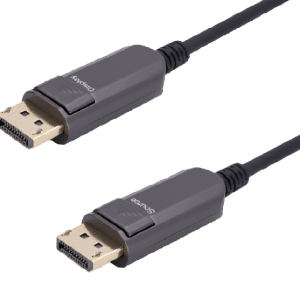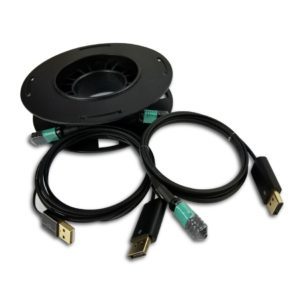DisplayPort (DP) is a digital video and audio inference that was designed by Video Electronics Standards Association (VESA) to replace analog connection such as VGA (Video Graphics Array) and DVI (Digital Visual Interface). DisplayPorts are commonly used to connect computer systems to monitors and are not frequently found in devices such as Tv’s. DisplayPort is similar to HDMI 2.0 in that it can transmit data 2160p 4K at 60Hz. DisplayPort uses packetized data, like USB and Ethernet, to send digital display and audio data and can transmit audio and video signals simultaneously.
Watch the webinar about the “Latest Trends in Video over Fiber” >
DisplayPort 1.2 vs DisplayPort 1.4
DisplayPort 1.2 and 1.4 are the most popular versions on the market today. DisplayPort 1.2 supports an effective bandwidth to 17.28 Gbit/s in High Bit Rate 2 (HBR2) mode. The older DisplayPort 1.2 is capable of 3840×2160, 4K, at 60 Hz; or 1080p resolution at 144Hz.
DisplayPort 1.4 is the most recent version of DisplayPort capable of supporting total data throughput of 25.92 Gbit/s (HBR3) for transmitting 4K 3840 × 2160 at 120 Hz and 5K 5120 × 2880 at 60 Hz. DisplayPort 1.4 supports Display Stream Compression 1.2 (DSC). DSC is a “visually lossless” encoding technique with up to a 3:1 compression ratio. Visually lossless means that there is no perceivable difference in the quality of the image or video while compression is active. Using DSC with HBR3 transmission rates, DisplayPort 1.4 can support 8K UHD (7680 × 4320) at 60 Hz.
One unique feature of DisplayPorts is that it can support multi-stream transport which allows multiple independent displays per port making it very valuable for video wall applications. A single DisplayPort interface can support four monitors and with daisy chaining can support six.
Latest standard versions support resolutions and bandwidths higher than prior versions.
| Parameter | DP 1.2 | DP 1.4 |
|---|---|---|
| Effective Bandwidth | 17.28 Gb/s | 25.92Gb/s |
| Max Resolution | 4K UHD @ 60Hz | 8K UHD @ 60Hz |
| High Dynamic Range (HDR) Support | No | Yes |
| Multi Stream Transport (MST) Support | Yes | Yes |
Fiber DisplayPort
Pure Fiber DisplayPort extenders take advantage of the great features of DisplayPort and enhances its capabilities with the benefits of fiber optics. DisplayPort Optical Cable fully takes advantage of the high transmission bandwidth, low power consumption, and low EMI. The optical cable is suitable for high-speed, high-quality, long-distance and sensitive applications or systems such as hospital equipment and wireless device. Fiber DisplayPort cables can easily span distances as great as 100 meters without loss of signal or degradation.
Potential applications for a DisplayPort optical cable include digital signage, surveillance, home theatre, conference room, control centers, auditorium, medical imaging, and stadiums.
Related Products



